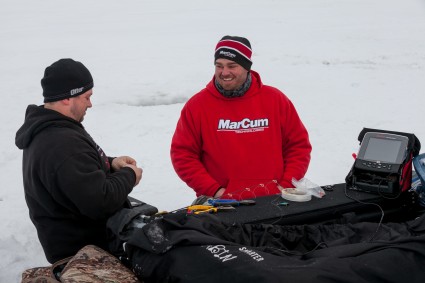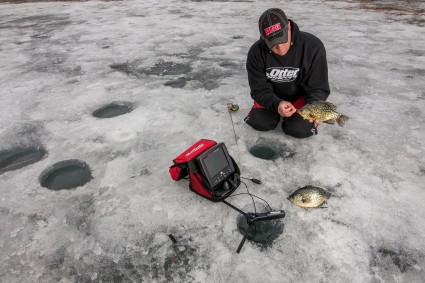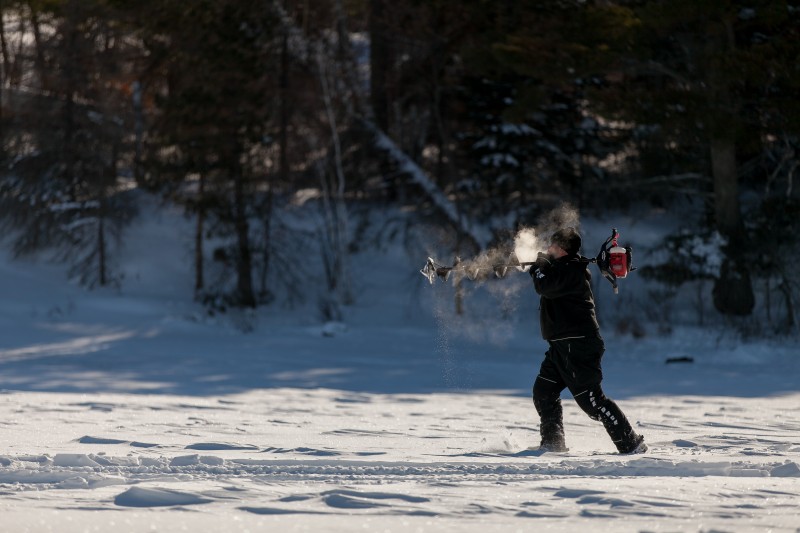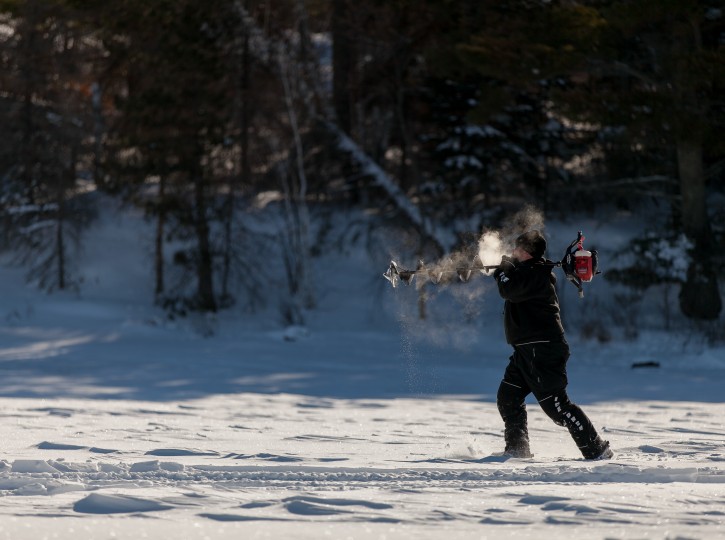It’s mid-winter everyone, and we know what that means. Fish are lethargic and you’re in a bad mood. Maybe cabin-fever has set in. Maybe you’re sick of plowing and shoveling snow. Perhaps you’re just bummed out about the fact that the past few fishing excursions have proven half as fruitful as your early season forays. Whatever the reason, it’s time for a full-on fishing intervention. That’s right, you’re in need of an attitude adjustment, but can the power of positive thinking alone lead to more fish during the “dog-days” of winter? You’re about to find out.
I’m not talking about a Tony-Robbin’s-like pep-fest, I’m talking about knowledge and putting the best play into action for the situation at hand. That said, this isn’t as tactical as it is mind-over-matter. The fish are there, and they have to eat. Sure, they might be eating less, and you’ve got 101 excuses to add to why the fishing is tough right now. Not to mention, it’s just not as “easy” as it can be early or late, but the sooner you accept that fact, the better off you’ll be. You’ll have to work harder and dig deeper into your bag of tricks to make it happen this time of the year, and success should be gauged accordingly. There’s lots of factors out there now that you can’t change, but it’s time to take control of the variables you can, and let the rest of the chips fall where they may.
 We can’t decide for the fish where they’ll be during this time of year, but the first step in getting your head screwed on straight when it comes to mid-winter fishing, is reminding yourself that you CAN control where you fish. One of the cardinal rules of fishing is that you can’t catch fish where they’re not, so stop hanging around your first-ice jaunts fishing a memory and head to predictable mid-winter fishing locations. For many species right now, that can be the deepest water in the lake, especially when you’re talking about crappies. And let’s get one thing straight, to find fish this time of year, it’s just going to take more holes. Fish activity levels have diminished, and I firmly believe that they simply travel less this time of the year, making it much less likely for you to encounter a wandering fish if you’re completely stationary. More holes equals more fish during this time of year, and often you’ll have to drop it right on them to get them to eat, especially mid-day.
We can’t decide for the fish where they’ll be during this time of year, but the first step in getting your head screwed on straight when it comes to mid-winter fishing, is reminding yourself that you CAN control where you fish. One of the cardinal rules of fishing is that you can’t catch fish where they’re not, so stop hanging around your first-ice jaunts fishing a memory and head to predictable mid-winter fishing locations. For many species right now, that can be the deepest water in the lake, especially when you’re talking about crappies. And let’s get one thing straight, to find fish this time of year, it’s just going to take more holes. Fish activity levels have diminished, and I firmly believe that they simply travel less this time of the year, making it much less likely for you to encounter a wandering fish if you’re completely stationary. More holes equals more fish during this time of year, and often you’ll have to drop it right on them to get them to eat, especially mid-day.
The second variable in our control is when we fish. Not just in terms of what time of day, but what weather patterns. For those that follow the In-Depth Outdoors forums, many of us have discussed extensively the benefits of pre-frontal conditions as indicated by a stalled barometer just starting to make its plunge into the abyss. I’ve experienced great bites during long-lasting cold high fronts during this time of the year as well, so you’re looking for a downward trending barometer, or a fairly stable one. Bite windows are more important now than they’ve ever been. Heavier snow cover during this period cuts down light levels, so the effect of losing light is more important than it typically is compared to first ice. You’ll want to be in a high-likelihood location at first and last light for most species this time of year. It very well may be the only crack you get at fish during this time period, so spend your daytime drilling and be ready to ride out locations towards dark.
 Yet another factor to success right now is what water body you decide to fish. For anyone who’s studied fish on underwater cameras, you know what they do, especially in shallow water, when people walk over them or trucks drive over them. Pressure during this time of year means overhead vehicle traffic as much as it does lines in the water. That’s why this is my favorite time of year to head off on a wild-goose chase. Excursion fishing at its finest, I’m talking about getting your gear together and hitched to a sled for some backwoods adventures. If that’s not in the cards for you, and you fish bigger more popular bodies of water, small changes in location away from the crowd can mean the difference between fish present and fish present and accounted for on top of the ice.
Yet another factor to success right now is what water body you decide to fish. For anyone who’s studied fish on underwater cameras, you know what they do, especially in shallow water, when people walk over them or trucks drive over them. Pressure during this time of year means overhead vehicle traffic as much as it does lines in the water. That’s why this is my favorite time of year to head off on a wild-goose chase. Excursion fishing at its finest, I’m talking about getting your gear together and hitched to a sled for some backwoods adventures. If that’s not in the cards for you, and you fish bigger more popular bodies of water, small changes in location away from the crowd can mean the difference between fish present and fish present and accounted for on top of the ice.
 Managing the factors within our control is important, but so is adjusting to those which are not. A prime example would be fish that don’t eat. If fish on the flasher that don’t bite drive you to insanity, you might want to sit this one out, because mid-winter fish are all about the window-shopping and there’s not a lot you can do about it. You’ll mark gobs of fish before you’ll actually get one to eat, which everyone agrees is frustrating, especially when you only get 15 minutes of activity per day towards last light. The key there is fishing more often, for shorter durations. There’s nothing like time in the great laboratory of fishing, and like any good chemist, you can’t mix up the proper concoctions without enough time in the lab. If fish are the subject to this grand experiment, it helps to have them there as well. Accept that some days you’ll do nothing more than provide a host of offerings in the hopes of cracking the code. This may mean the difference between offering vertical vs. horizontal presentations, variations in bait type, color, profile, vibration, and any other numbers/types of experimentation. Consider it an investment in the future of your fishing, both for the immediate and long-term future. This mid-winter period can extend well into March depending on the weather, so it’s key that you study and learn as much as you can to improve fishing moving into that time of year.
Managing the factors within our control is important, but so is adjusting to those which are not. A prime example would be fish that don’t eat. If fish on the flasher that don’t bite drive you to insanity, you might want to sit this one out, because mid-winter fish are all about the window-shopping and there’s not a lot you can do about it. You’ll mark gobs of fish before you’ll actually get one to eat, which everyone agrees is frustrating, especially when you only get 15 minutes of activity per day towards last light. The key there is fishing more often, for shorter durations. There’s nothing like time in the great laboratory of fishing, and like any good chemist, you can’t mix up the proper concoctions without enough time in the lab. If fish are the subject to this grand experiment, it helps to have them there as well. Accept that some days you’ll do nothing more than provide a host of offerings in the hopes of cracking the code. This may mean the difference between offering vertical vs. horizontal presentations, variations in bait type, color, profile, vibration, and any other numbers/types of experimentation. Consider it an investment in the future of your fishing, both for the immediate and long-term future. This mid-winter period can extend well into March depending on the weather, so it’s key that you study and learn as much as you can to improve fishing moving into that time of year.
For many anglers, a good memory can be a terrible fishing partner. Rose colored glasses prevent us from seeing the days that we crushed the fish, for what they really were. Just points in time. Instead, think back to the days where nothing worked, no matter what you did, until you tried X, Y, or Z, and then the fishing gods smiled, pouring out their bounty onto the ice for you and your buddies. These are the memories that fuel me when the going gets tough. The best part about fishing, is that it’s a hopeful sport. In fact, one of my favorite quotes of all time comes from John Buchannon – “The charm of fishing is that it is the pursuit of what is elusive but attainable, a perpetual series of occasions for hope.” When translated to plain English, to me it means that the next fish is right around the corner. In the next hole you drill, the next move across the lake you make, or the next body of water you decide to fish. The best anglers I’ve ever fished with never give up, and too often have I seen them greatly rewarded for their persistence to ever consider throwing in the towel myself. I get it. Fishing will be more difficult in February and into March. Deal with it. Adjust to it. Manipulate it into the necessary drive you need to fuel your fire. People that catch fish during this time of the year, consistently, are amongst the anglers I look up to, because they understand that the biggest challenge they face is a mental one.

thanks for the great read joel…… the best of ice fishing this year is yet to come!